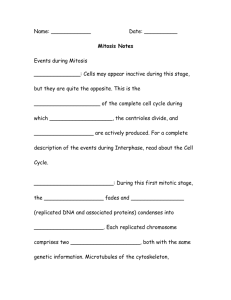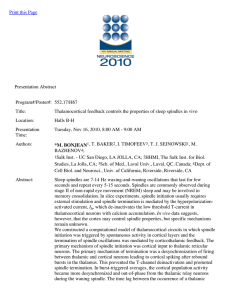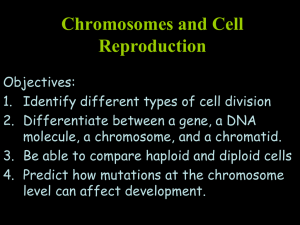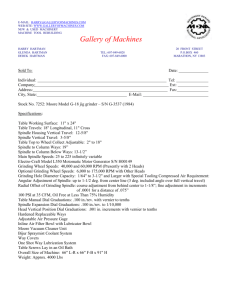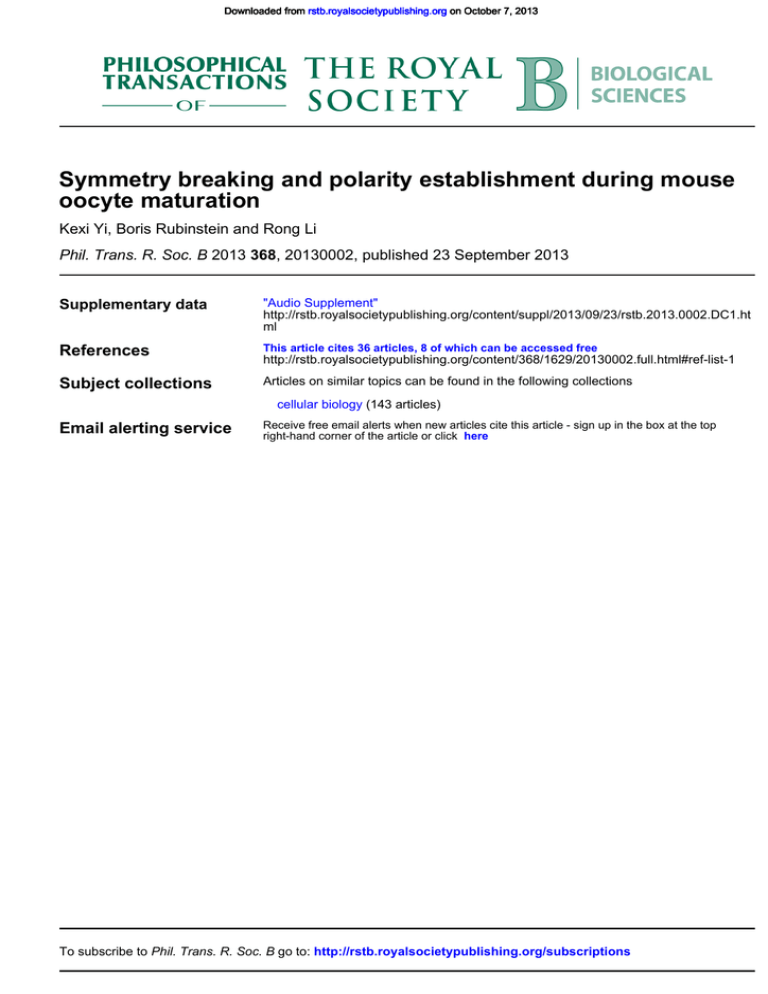
Downloaded from rstb.royalsocietypublishing.org on October 7, 2013
Symmetry breaking and polarity establishment during mouse
oocyte maturation
Kexi Yi, Boris Rubinstein and Rong Li
Phil. Trans. R. Soc. B 2013 368, 20130002, published 23 September 2013
Supplementary data
"Audio Supplement"
http://rstb.royalsocietypublishing.org/content/suppl/2013/09/23/rstb.2013.0002.DC1.ht
ml
References
This article cites 36 articles, 8 of which can be accessed free
Subject collections
Articles on similar topics can be found in the following collections
http://rstb.royalsocietypublishing.org/content/368/1629/20130002.full.html#ref-list-1
cellular biology (143 articles)
Email alerting service
Receive free email alerts when new articles cite this article - sign up in the box at the top
right-hand corner of the article or click here
To subscribe to Phil. Trans. R. Soc. B go to: http://rstb.royalsocietypublishing.org/subscriptions
Symmetry breaking and polarity
establishment during mouse
oocyte maturation
Kexi Yi1, Boris Rubinstein1 and Rong Li1,2
rstb.royalsocietypublishing.org
1
Stowers Institute for Medical Research, 1000 East 50th Street, Kansas City, MO 64110, USA
Department of Molecular and Integrative Physiology, University of Kansas Medical Center,
3901 Rainbow Boulevard, Kansas City, KS 66160, USA
2
Review
Cite this article: Yi K, Rubinstein B, Li R.
2013 Symmetry breaking and polarity
establishment during mouse
oocyte maturation. Phil Trans R Soc B 368:
20130002.
http://dx.doi.org/10.1098/rstb.2013.0002
One contribution of 17 to a Discussion Meeting
Issue ‘Cellular polarity: from mechanisms to
disease’.
Subject Areas:
cellular biology
Keywords:
symmetry breaking, polarity establishment,
spindle migration, actin dynamics
Author for correspondence:
Kexi Yi
e-mail: kyi@stowers.org
Mammalian oocyte meiosis encompasses two rounds of asymmetric divisions to generate a totipotent haploid egg and, as by-products, two small
polar bodies. Two intracellular events, asymmetric spindle positioning and
cortical polarization, are critical to such asymmetric divisions. Actin but
not microtubule cytoskeleton has been known to be directly involved in
both events. Recent work has revealed a positive feedback loop between
chromosome-mediated cortical activation and the Arp2/3-orchestrated cytoplasmic streaming that moves chromosomes. This feedback loop not only
maintains meiotic II spindle position during metaphase II arrest, but also
brings about symmetry breaking during meiosis I. Prior to an Arp2/3dependent phase of fast movement, meiotic I spindle experiences a slow
and non-directional first phase of migration driven by a pushing force
from Fmn2-mediated actin polymerization. In addition to illustrating these
molecular mechanisms, mathematical simulations are presented to elucidate
mechanical properties of actin-dependent force generation in this system.
1. Introduction
The mammalian oocyte undergoes two consecutive rounds of extremely asymmetric divisions to generate a large haploid egg and two small polar bodies.
Such asymmetric divisions are dictated by intracellular asymmetries developed
within the oocyte prior to anaphase onset, which includes asymmetric spindle
positioning and cortical polarization [1,2]. Owing to its amenability to optical imaging and genetic manipulations, as well as a robust ability to undergo maturation
in culture, mouse oocytes have been recognized as one of the best models to understand these events. When maturing in vitro, the meiotic I (MI) spindle of the mouse
oocyte is assembled at or near the cell centre after germinal vesicle breakdown
(GVBD). Shortly after chromosome alignment, the chromosomes–spindle complex initiates its migration towards one side of the cortex. Accompanying this
process is the establishment of cortical polarity characterized by an actin-enriched
domain surrounded with a myosin ring [3–6]. At anaphase, coordinated protrusion of the actin-enriched domain and constriction of the myosin ring lead to
extrusion of the first polar body containing one set of homologous chromosomes
[7–9]. Following the first polar body extrusion, the oocyte proceeds into the metaphase of meiosis II where an MII spindle is assembled near the first division site
beneath the cortex. A cortical actomyosin domain similar to that in the MI is
again established above the spindle. The oocyte is now fully mature and arrests
at this stage awaiting fertilization (figure 1).
Both spindle positioning and cortical polarization rely on actin dynamics
but not microtubules (see review in Sun & Schatten [10]). Recent works have
revealed the underlying mechanisms that drive these events during meiosis I
and II [11 –15]. In this review, we present a comprehensive working model
for spindle positioning and cortical polarization during mouse oocyte maturation, mainly based on our recently published works [5,13,16,17]. We begin
by describing a positive feedback loop that connects cortical polarity and asymmetric spindle positioning. We discuss how this feedback loop is critical for
& 2013 The Author(s) Published by the Royal Society. All rights reserved.
0h
5h
12 h
meiosis I
first PB
rstb.royalsocietypublishing.org
meiosis II
cortical actomyosin domain
GVBD
2
second PB
symmetry breaking
spindle assembly spindle migration metaphase II arrest
fertilization
maintaining oocyte polarity during prolonged MII arrest, and
how it is used, together with Fmn2-mediated actin polymerization, to transport the MI spindle in meiosis I. Finally,
we introduce a simple mechanical model that explains
how the actin-dependent forces are generated during these
processes.
cortical actomyosin
actin
Arp2/3
2. A positive feedback loop drives spindle
positioning and cortical polarization
(a) Meiotic chromosomes signal the establishment of
cortical polarity
The cortical actomyosin cap is a structure essential for polar
body extrusion. It is established in meiosis I when the spindle
has migrated close to the cortex and during metaphase II arrest
where the spindle is asymmetrically positioned beneath the
cortex [2,5]. Previous studies suggested that establishment of
such a cortical structure depends on signals from chromosomes
(figure 2). Each chromosome mass dispersed by nocodazole
treatment induced an actin cap at the overlying cortex [1].
Injected sperm heads or DNA-coated beads at the cortex
promoted formation of a similar structure [5,18]. It was demonstrated that chromatin induction of the cortical domain is
mediated through an ‘at a distance’ effect: chromosomes or
DNA stimulate formation of the cortical domain without
physically interacting with the cortex, provided that it is
within a distance of 20–25 mm. The capacity to induce the
cortical domain is inversely related to this distance. The ‘at a
distance’ effect from chromosomes on cortical polarity is similar to the one from chromosomes to induce spindle formation,
where a Ran guanosine triphosphate (RanGTP) gradient, established by the spatially separated actions of Ran guanine
nucleotide exchange factors (GEF) and Ran GTPase activating
protein (GAP), is used to transmit the chromosome signal [19–
21]. Indeed, the RanGTP gradient is present in both MI and MII
oocytes [22]. In oocytes undergoing meiosis II, the RanGTP gradient is involved in mediating the chromosome signal to the
cortex, as both dominant negative and constitutively active
Ran mutants disrupted DNA-induced cortical polarization.
Thus, similar to its role in spindle assembly, the RanGTP gradient also serves as a molecular ruler for cortical polarization in
N-WASP WAVE
Cdc42
cytoplasmic
streaming
Rac
Ran gradient
chromatin
Figure 2. Molecular pathway leading to a positive feedback between chromosomes–spindle positioning and cortical polarization. When the spindle is in the
vicinity of the cortex, the chromatin-mediated RanGTP gradient activates N-WASP
and the Arp2/3 complex via Cdc42 at the cortex to nucleate actin polymerization, which suppresses premature myosin II ring contraction and promotes
cytoplasmic streaming to maintain spindle positioning. Rac1-WAVE2 may
serve as a parallel pathway to activate the Arp2/3 complex, and this pathway
is also under the control of the Ran gradient. (Online version in colour.)
mouse oocytes [5]. It is worth noting that, in both mouse and
frog oocytes, mutant Ran perturbed meiotic II spindle assembly
but had little effect on meiotic I spindle assembly and first polar
body extrusion [22], which raises a question of whether chromosomes in meiosis I signal cortical polarity through molecular
mechanisms other than the RanGTP gradient.
One of the cytoskeletal targets of the RanGTP gradient is the
Arp2/3 complex, as mutant Ran disrupts cortical localization
and activation of the Arp2/3 complex in MII mouse oocytes
[17] (figure 2). The Arp2/3 complex is a type of actin nucleator
that nucleates new F-actin to form a Y-shaped branch off a preexisting filament. It is well known that Arp2/3-dependent
actin dynamics are critical to leading edge protrusion in
migrating cells [23]. In MII oocytes, it is localized to the cortical
cap and promotes actin polymerization in this region.
Phil Trans R Soc B 368: 20130002
Figure 1. Meiotic maturation of a mouse oocyte. The prophase I-arrested oocyte resumes cell cycle progression and enters its maturation process upon hormone stimulation.
The MI spindle is assembled approximately 5 h after germinal vesicle breakdown (GVBD) in cultured oocytes. It migrates towards one side of the cortex along the long axis
once the chromosomes are aligned. Immediately after first polar body (PB) extrusion, the MII spindle is formed beneath the cortex, and the subcortical position is maintained
through the metaphase II arrest. Later, fertilization triggers MII completion resulting in a second polar body extrusion. In both meiosis I and II, accompanying asymmetric
spindle positioning is the formation of a cortical actomyosin cap induced by subcortically located chromosomes. (Online version in colour.)
It was thought that the sole purpose of the actomyosin cap is to
facilitate polar body extrusion. However, inhibition of Arp2/3
or its activator N-WASP induces spindle detachment from the
cortex in metaphase-II-arrested oocytes. This suggests that not
only are the chromosomes responsible for establishing the cortical actin domain, but also that actin polymerization at the
cortex, in turn, impacts chromosomes/spindle positioning
[17]. Using a live F-actin probe, GFP-UtrCH, it was observed
that actin filaments nucleated by cortical Arp2/3 flow inwardly
towards the cell interior [17]. Intriguingly, the actin flow drives
cytoplasmic streaming in the mouse oocyte. Cytoplasmic
particles flow away from the polar cap along both sides of
the cortex towards the opposite side of the oocyte, where the
direction is reversed and the particles move towards the spindle
from the cell centre. Mathematical simulation and experimental
data suggested that cytoplasmic streaming generates a constant
pushing force, which is critical to maintain spindle positioning
during metaphase II arrest (see next section on force generation). To promote spindle positioning, the cortical Arp2/3nucleated actin polymerization not only drives cytoplasmic
streaming, but just as importantly, it also suppresses premature
contraction of the myosin II ring around the actin cap. When the
Arp2/3 activity is inhibited, contraction of the myosin II ring
results in a reverse streaming that drives the spindle away
from the cortex.
As such, asymmetric positioning of the MII spindle is
achieved through a dynamic mechanism involving Arp2/
3-nucleated actin assembly from the cortical cap. The mechanism is distinct from the one implicated in most other cell types
where asymmetric spindle positioning is accomplished by the
cortical dynein complex pulling on astral microtubules [29].
This correlates with the fact that meiotic spindle in the mammalian oocyte lacks conventional centrosomes and astral
(c) Hydrodynamic simulation confirms a pushing force
from cytoplasmic streaming
To test whether cytoplasmic streaming can exert a pushing
force on the spindle towards the cortex, a hydrodynamic
model was proposed [17]. Full-scale simulation of actin
flow and cytoplasmic streaming in the oocyte is a demanding
computational problem as it requires consideration of twophase liquid three-dimensional dynamics in a complex
geometry. As the observed flow demonstrates rotational symmetry and the cytoplasmic streaming follows the actin flow,
one may reduce the simulation to two-dimensional cytosolic
flow in a plane produced by the cross section of the oocyte
along the animal –vegetal axis. The spindle is represented
as an immovable obstacle that can be considered a solid
impenetrable body or a partially penetrable object with a
specific shape. The flow velocity as well as the fluid pressure
distribution is computed as a solution to the Navier–Stokes
equation for incompressible fluid
@u
rp
þ nr2 u;
þ u ru ¼ @t
r
where u denotes the fluid velocity, p is the pressure and r and n
are the density and kinematic viscosity of the fluid, respectively.
The equation is supplied by the no-slip (zero fluid velocity
u ¼ 0) condition on the circular boundary of the region representing the oocyte cortex. The flow source mimicking the
Arp2/3-complex-dependent actin flow in the oocytes in this
geometry is located above the spindle at the symmetry axis
between the spindle and the cortical membrane. The simulations show that establishment of a steady-state cytosolic
flow accompanied by the pressure difference on the top and
bottom surfaces of the spindle obstacle generates a force maintaining the spindle position close to the cortical membrane. In
the case of Arp2/3 inhibition, the actomyosin contraction is
modelled by a flow sink in the same location between the spindle and the cortical membrane. The cytosolic flow has an
opposite direction and the resulting pressure difference drives
the spindle away from the cortex.
Force generation from cytoplasmic streaming is also
supported by the experimental data. For example, the chromosome mass was observed to be pushed towards the cortex once
it was released from the spindle by nocodazole treatment [17].
It was also demonstrated that the detached spindle moved back
towards the cortex along with the cytoplasmic particles after
the streaming resumed in CK-666 wash-out oocytes. Cytoplasmic streaming was first recorded in MII-arrested oocytes,
and the hydrodynamic model was originally developed
to explain the pushing force accounting for spindle position
maintenance in MII-arrested oocytes. However, it was recently
revealed that the force generated by Arp2/3-orchestrated
cytoplasmic streaming is also involved in moving the spindle towards the cortex during the fast phase of MI spindle
migration [13], as discussed in detail below.
3
Phil Trans R Soc B 368: 20130002
(b) Cortical actin assembly promotes chromosome
and spindle positioning
microtubules. One important feature of such a dynamic mechanism is the positive feedback loop between cortical
polarization and spindle positioning: the MII chromosomes
activate Arp2/3-mediated actin polymerization through Ran
signalling to suppress premature myosin II ring contraction
and to drive cytoplasmic streaming. The cytoplasmic streaming, in turn, exerts a pushing force on the spindle towards
the cortex thus keeping the chromosomes and spindle in place.
rstb.royalsocietypublishing.org
Inhibition of Arp2/3 or its activator N-WASP diminished actin
cap formation [17,24]. Cdc42, a Rho GTPase that regulates
Arp2/3 activity through N-WASP in many cell types, was
recently found to be accumulated at cortical cap in a
Ran-dependent manner [7]. Inhibition of Cdc42 activity led
to N-WASP mislocalization, cortical actin cap loss and spindle
organization/migration failure [7,25]. These observations
indicated that a Cdc42-N-WASP-Arp2/3 pathway operates
downstream of Ran signalling to regulate cortical actin cap formation. In addition to Cdc42, another small GTPase, Rac1, is
also localized to the cortical cap region under the control of
the RanGTP gradient and inhibiting its activity led to similar
defects in spindle positioning [26,27]. It is possible that
Rac1 regulates cortical actin cap through its specific effector
WAVE2, which was indicated to be involved in oocyte
polarization in MI, presumably due to failed Arp2/3 localization/activation [28]. These results suggest that multiple
signalling pathways are engaged in cortical actin assembly
downstream of the master regulator, the RanGTP gradient. As
to how RanGTP executes its function to regulate these signalling
pathways, in the case of spindle morphogenesis, RanGTP binds
to importins competitively, thus triggering release of microtubule polymerization factors to support spindle assembly [19].
A similar mechanism might be at work to enable activation
of the Arp2/3 during cortical polarization but the immediate
effector of RanGTP remains unknown.
(a)
4
rstb.royalsocietypublishing.org
3. Biphasic model of symmetry breaking and
spindle migration in meiosis I
(a) Fmn2-mediated actin polymerization drives the
initial phase of spindle migration
phase II
phase I
chromatin signal
Fmn2-decorated ER
F-actin
Arp2/3 complex
(b)
Fmn2
actin assembly at
spindle periphery
(I)
chromosome
movement
actin-driven
cytoplasmic
streaming
(II)
Arp2/3
cortical activation
oocyte polarity
Figure 3. Biphasic chromosome migration and symmetry breaking in mouse
oocytes. (a) Consecutive actin-based forces driving chromosome migration.
Soon after the formation of the metaphase MI spindle, Fmn2 localized on
ER vesicles generates random and slow spindle/chromosome motion via actin
polymerization at the spindle periphery (phase I). Once the chromosomes
move to a position where a diffusible chromatin-generated signal could
reach the cortex, the Arp2/3 complex becomes activated at the cortex and
nucleates actin polymerization that drives cytoplasmic streaming, pushing the
chromosomes rapidly towards the cortex (phase II). (b) A positive feedback
loop drives decisive symmetry breaking in MI oocytes. (Online version in colour.)
no obvious asymmetry of Fmn2 or F-actin distribution when
the spindle is intact [13]. Considering this fact, it was proposed
that symmetric Fmn2 nucleation generates a random and stochastic pushing force on the spindle, which drives the spindle
to migrate in a random manner. Indeed, trajectory tracking
and mean square displacement (MSD) analysis of spindleintact or spindle-less chromosome movement suggested that
the first 5–10 mm of migration is slow and non-directional [13].
(b) Arp2/3-orchestrated cytoplasmic streaming drives a
phase of fast spindle movement
Following an initial phase of spindle migration characterized
as a random walk, the second phase of spindle motion is
faster and more directional [13]. Concurrent with the fastphase spindle movement, cytoplasmic streaming was
observed. The streaming lasted after first polar body extrusion and continued to maintain the MII spindle at the
cortex during MII arrest. Not surprisingly, the Arp2/3 complex is recruited to the MI cortical cap at the onset of the
fast migration phase. Inhibiting Arp2/3 activity abolishes
cytoplasmic streaming, thus resulting in abolishment of the
second phase of straight and accelerated movement. The
Phil Trans R Soc B 368: 20130002
Unlike in meiosis II where the major challenge is to maintain
spindle and cortical asymmetry during a prolonged metaphase
arrest, in meiosis I, the chromosomes–spindle complex has to
migrate to one side of the cortex to prepare for first polar
body extrusion. Spindle migration is a critical symmetry breaking step in that it not only establishes its own positional
asymmetry, but also in that the chromosomes induce cortical
polarization. Previous studies established that actin dynamics
and Fmn2, a member of the formin family of actin nucleators,
are critical for spindle migration [14,30]. Fmn2 localizes to the
oocyte cortex as well as the central region of the oocyte
around the spindle [16,31,32]. Correspondingly, intracellular
actin filaments were observed to be enriched around the spindle
by using multiple probes, including Lifeact (EGFP [33] and
FITC labelled [16]), GFP-UtrCH and fluorescently labelled
phalloidin [13]. We reported recently that Fmn2 is recruited
to the vesicular endoplasmic reticulum (ER) structures around
the spindle. This pool of Fmn2 is critical to actin polymerization
around the spindle and spindle migration as its disruption
causes spindle migration defects [13].
As an actin nucleator, Fmn2 is expected to drive spindle
migration through its capability to regulate actin dynamics.
Indeed, Fmn2 is responsible for the assembly of actin filaments
prior to spindle migration, and lack of a cytoplasmic actin
network has been observed in Fmn2 null oocytes [31,32,34].
Importantly, overexpression of Fmn2 evoked bulk accumulation of actin filaments around the spindle [34]. This
population of F-actin is absent from Fmn2 null oocytes and is
resistant to Arp2/3 inhibitor [13]. These observations suggest
that spindle periphery ER-residing Fmn2 nucleates actin
polymerization to promote spindle migration. Cortical Fmn2,
previously thought to be involved in spindle migration, is
associated largely with microvilli. When the spindle approaches
the cortex, the cortical Fmn2 is gradually cleared from the area
facing the approaching spindle [13]. This is in accordance with
exclusion of the microvilli from the cortical cap region, but is in
contrast to the view that Fmn2 nucleates cytoplasmic actin
filaments from the cortex to pull the incoming spindle.
Although an earlier study proposed that cortical Fmn2nucleated F-actin provides a track for spindle-pole-associated
myosin II to pull the spindle [32], emerging evidence suggests
that Fmn2-mediated actin polymerization may instead exert a
direct pushing force [13,34]. In GV-arrested oocytes, moderate
Fmn2 overexpression induced local accumulation of Fmn2 and
actin filaments on the GV membrane, which was observed to
push the GV to migrate towards the cortex. In the case of
chromosome migration without an intact spindle, Fmn2
remained associated with a spindle remnant structure. It was
shown that the chromosomes always migrated towards the
cortex with the spindle remnant and Fmn2 lagging behind,
further suggesting that Fmn2-mediated actin polymerization
pushes the chromosomes forward [13]. It was previously
hypothesized that Fmn2-nucleated actin polymerization propels spindle migration by a mechanism similar to the one
harnessed by Listeria or verprolin central acidic domaincoated beads [16,35,36]. However, careful examination
indicated that, prior to the start of spindle migration, there is
(a)
a-value
1.5
F
zone 2
rstb.royalsocietypublishing.org
stochastic random pushing force
zone 1
zone 2
5
(c) 2.0
zone 1
directional force
1.0
0.5
distance
0
phase I
0.5
0.3
0.1
–0.1
0
0.5
1.0
1.5
x (arb. units)
2.0
2.5
(e)
35
1.00
84%
0.75
25
percentage
count
(d)
a
phase II
Phil Trans R Soc B 368: 20130002
y (arb. units)
(b)
15
0.50
0.25
51%
19%
5
0
10
20
30 40 50
angle (°)
60
70
80
0
Figure 4. Modelling biphasic spindle movement in mouse oocytes. (a) Schematic of model assumptions. Stochastic random pushing forces generated by Fmn2-mediated
actin polymerization are applied from all directions around the spindle in zone 1. The net force is computed by as a vector sum of individual forces applied to the spindle
centroid and split into two components: parallel F1 and normal F2 to the direction of the spindle long axis. The velocity vi in these two directions is computed using the
formula: vi ¼ giFi/(6p m), where m is the cytosolic viscosity and gi is the shape factor ( g1 . 1, g2 , 1) reflecting the motion along and normal to the axis. When
the spindle centroid reaches the boundary of Arp2/3 activation by the chromatin (zone 2), cytoplasmic streaming is turned on and produces an additional force parallel to
the long spindle axis towards the closest cortex. The dependence of the magnitude F of this force on the distance d between spindle centroid and cortex was modelled
using an FðdÞ expðbdÞ exponential function. All simulations were performed using MATHEMATICA. (b) A representative trajectory generated by the model simulation.
(c) a value of the MSD analysis of the trajectories generated from 200 simulations. Histograms show mean and s.e.m. (d) The model predicts that spindle migration is
biased along the longer axis. The angle between the long spindle axis and the vector of its migration was calculated from 200 simulated trajectories. The histograms
show binned counts of the angles from the 200 simulations. (e) The model predicts that off-centred spindle tends to move in the direction of the proximal cortex. The
simulation was run under three situations, where the spindle centroid is at the oocyte centre (red dot), off-centre closer to the upper cortex, or off-centre farther from the
upper cortex. The percentage of the cases where the spindle migrates to the upper cortex was calculated from 100 simulations. (Online version in colour.)
facts that streaming speed increases as the chromosome-tocortex distance shortens and that the spindle migrates at an
increasing speed suggest a mutual enhancement between
Arp2/3 activation and chromosome migration, similar to
the positive feedback loop responsible for spindle position
maintenance in MII oocytes. It is of note that the function
of Fmn2 may not be to simply generate the first phase of
chromosome movement, because in a Fmn2 null oocyte
Arp2/3 activation and cytoplasmic streaming were not
initiated even when the chromosomes were naturally placed
near the cortex.
(c) A biphasic model for symmetry breaking and
spindle migration
Based on the work described above, it was proposed that symmetry breaking and chromosomes/spindle migration are
accomplished by a two-phase process (figure 3a). The first
phase is driven by a pushing force generated from actin
polymerization nucleated by ER-bound Fmn2 at the spindle
periphery. Although this movement is non-directional, it can
move the chromosomes and spindle to a position closer to
the cortex. Once the chromosomes reach a position within a
range of 20–25 mm to the cortex, it stimulates an Arp2/3orchestrated cytoplasmic streaming that further pushes the
spindle towards the cortex in a fast and directed manner. In
this model, the Fmn2-mediated migration does not result in
symmetry breaking, and decisive symmetry breaking occurs
when the chromosomes are within a certain distance of the
cortex, as a result of a positive feedback between the Arp2/
3-dependent cortical actin polymerization and chromosome
movement itself. This model of symmetry breaking is different
from previous ‘pulling’ and ‘pushing’ models, both of which
proposed that symmetry breaking takes place at the onset of
spindle migration, with one suggesting it to be a result of
one spindle pole winning a tug-of-war by pulling with
To test the above model, a mathematical model is developed
that assumes stochastic forces applied from all directions
around the spindle in a zone (zone 1) concentric with the
oocyte with a radius at the threshold for cortical Arp2/3 activation by the chromatin signal (figure 4a). Only the net force
that goes through the spindle centre is considered because
this force does not generate rotation rather displacement.
The difference in the drag force when the spindle moves in
different directions relative to the spindle axis is estimated
by the observed dimension of the spindle. If the chromosomes are beyond zone 1 (in zone 2), the Arp2/3 complex
is activated at the proximal cortex to initiate the cytoplasmic
streaming, which applies a directional pushing force on the
spindle towards the Arp2/3 domain, and the magnitude of
this force increases with decreasing distance between the
chromosomes and the cortex. Simulation of this mechanical
model, indeed, yields biphasic migration trajectories with
the first phase close to a random walk and the second
phase as straight directional motion (figure 4b,c).
In addition to the biphasic feature of spindle movement,
several other spindle migration characteristics have been
described. For example, it has been observed that the direction of the spindle migration is biased along its long axis.
This feature can be predicted by the model and is an outcome
of the difference in the magnitude of the drag force experienced by the spindle that favours pole-led, as opposed to
side-led, movement (figure 4d). Another previously noted
trend is that an off-centred spindle tends to move in the direction of the proximal cortex. Again, our mechanical model can
recapitulate this trend, which can be rationalized by the
increased likelihood for the chromosomes undergoing the
first phase of random motion to reach a zone 2 region close
to the proximal cortex and therefore initiate the fast migration
towards it (figure 4e).
6
As the critical events in asymmetric divisions during mouse
oocyte maturation, asymmetric spindle positioning and cortical polarization are interdependent: establishment of the two
relies on a feedback loop between chromatin-induced cortical
Arp2/3 activation and the Arp2/3-orchestrated cytoplasmic
streaming that exerts a force on the chromatin. The feedback
loop either maintains asymmetric spindle positioning at metaphase II or pushes the spindle to move towards the cortex
during meiosis I. The fact that cytoplasmic streaming continues from MI when the chromosomes are close to the
cortex to MII arrest indicates that a singular molecular mechanism underlies cytoplasmic streaming. Indeed, the Arp2/3
complex is activated at the cortex of both MI and MII oocytes
and is essential for the streaming. In metaphase II, the Arp2/3
complex is activated through a chromatin-dependent RanGTP
gradient; however, it is not known whether a similar pathway
activates Arp2/3 in meiosis I. As a profound characteristic in
mature oocytes, cytoplasmic streaming was speculated to be
an indicator for oocyte quality, which calls for further investigation into whether the extent of streaming correlates with
the oocyte’s developmental potential. Further, cytoplasmic
streaming apparently has an influence on distribution of the
proteins and organelles within a mature egg. It is tempting
to speculate that it has an impact on pre-cleavage patterning
of these intracellular materials.
Spindle migration in MI provides an example of how
forces generated by actin dynamics promote symmetry
breaking. It is interesting that two types of actin nucleators
were sequentially used to nucleate actin filaments in order
to propel spindle migration in oocytes, and that symmetry
breaking occurs as a result of positive feedback initiated
after partial chromosomes –spindle migration. Mathematical
simulation of the biphasic model captures the main features
of chromosome movement, thus providing a simple platform
for further exploration of the mechanical properties of this
motility. Future work should also elucidate how Fmn2 is
recruited to the vesicular ER and how this process is
temporally regulated during meiotic divisions.
Acknowledgements. We thank Brian Slaughter, Jay Unruh, Fengli Guo
and colleagues from the R. Li laboratory for discussions.
Funding statement. This work is supported in part by National Institutes
of Health grant no. P01 GM 066311.
References
1.
2.
3.
Longo FJ, Chen DY. 1985 Development of cortical
polarity in mouse eggs: involvement of the meiotic
apparatus. Dev. Biol. 107, 382 –394. (doi:10.1016/
0012-1606(85)90320-3)
Maro B, Johnson MH, Webb M, Flach G. 1986
Mechanism of polar body formation in the
mouse oocyte: an interaction between the
chromosomes, the cytoskeleton and the
plasma membrane. J. Embryol. Exp. Morphol.
92, 11 –32.
Verlhac MH, Lefebvre C, Guillaud P, Rassinier P,
Maro B. 2000 Asymmetric division in mouse
4.
5.
oocytes: with or without Mos. Curr. Biol. 10,
1303 –1306. (doi:10.1016/S0960-9822(00)00753-3)
Deng M, Williams CJ, Schultz RM. 2005 Role of MAP
kinase and myosin light chain kinase in
chromosome-induced development of mouse egg
polarity. Dev. Biol. 278, 358 –366. (doi:10.1016/j.
ydbio.2004.11.013)
Deng M, Suraneni P, Schultz RM, Li R. 2007 The Ran
GTPase mediates chromatin signaling to control
cortical polarity during polar body extrusion in
mouse oocytes. Dev. Cell 12, 301 –308. (doi:10.
1016/j.devcel.2006.11.008)
6.
7.
8.
Van Blerkom J, Bell H. 1986 Regulation of
development in the fully grown mouse
oocyte: chromosome-mediated temporal and
spatial differentiation of the cytoplasm and plasma
membrane. J. Embryol. Exp. Morphol. 93, 213 –238.
Dehapiot B, Carriere V, Carroll J, Halet G. 2013
Polarized Cdc42 activation promotes polar body
protrusion and asymmetric division in mouse
oocytes. Dev. Biol. 377, 202–212. (doi:10.1016/j.
ydbio.2013.01.029)
Liu XJ. 2012 Polar body emission. Cytoskeleton 69,
670–685. (doi:10.1002/cm.21041)
Phil Trans R Soc B 368: 20130002
(d) Mathematical simulation of biphasic spindle
migration and symmetry breaking
4. Summary and perspective
rstb.royalsocietypublishing.org
myosin II and the other emphasizing the importance of Fmn2/
F-actin distribution asymmetry [16,32]. By contrast, the biphasic model does not rely on an initial asymmetry in force
generation or Fmn2/F-actin distribution. It proposes that
establishment of spindle position asymmetry and cortical
polarity in MI oocytes is a consequence of Fmn2-mediated perturbation of spindle position and the positive feedback loop
described above (figure 3b).
9.
11.
13.
14.
15.
16.
17.
28. Sun SC, Xu YN, Li YH, Lee SE, Jin YX, Cui XS, Kim
NH. 2011 WAVE2 regulates meiotic spindle stability,
peripheral positioning and polar body emission in
mouse oocytes. Cell Cycle 10, 1853–1860. (doi:10.
4161/cc.10.11.15796)
29. Siller KH, Doe CQ. 2009 Spindle orientation during
asymmetric cell division. Nat. Cell Biol. 11,
365–374. (doi:10.1038/ncb0409-365)
30. Dumont J, Million K, Sunderland K, Rassinier P, Lim
H, Leader B, Verihac MH. 2007 Formin-2 is required
for spindle migration and for the late steps of
cytokinesis in mouse oocytes. Dev. Biol. 301,
254–265. (doi:10.1016/j.ydbio.2006.08.044)
31. Azoury J, Lee KW, Georget V, Rassinier P, Leader B,
Verlhac MH. 2008 Spindle positioning in mouse
oocytes relies on a dynamic meshwork of actin
filaments. Curr. Biol. 18, 1514– 1519. (doi:10.1016/
j.cub.2008.08.044)
32. Schuh M, Ellenberg J. 2008 A new model for
asymmetric spindle positioning in mouse oocytes.
Curr. Biol. 18, 1986–1992. (doi:10.1016/j.cub.
2008.11.022)
33. Zheng P, Baibakov B, Wang XH, Dean J. 2013
PtdIns(3,4,5)P3 is constitutively synthesized and
required for spindle translocation during meiosis in
mouse oocytes. J. Cell Sci. 126, 715 –721.
34. Azoury J, Lee KW, Georget V, Hikal P, Verlhac MH.
2011 Symmetry breaking in mouse oocytes requires
transient F-actin meshwork destabilization.
Development 138, 2903–2908. (doi:10.1242/
dev.060269)
35. Kuo SC, McGrath JL. 2000 Steps and fluctuations
of Listeria monocytogenes during actin-based
motility. Nature 407, 1026–1029. (doi:10.1038/
35039544)
36. Bernheim-Groswasser A, Wiesner S, Golsteyn RM,
Carlier MF, Sykes C. 2002 The dynamics of actinbased motility depend on surface parameters.
Nature 417, 308– 311. (doi:10.1038/417308a)
7
Phil Trans R Soc B 368: 20130002
12.
18. Deng M, Kishikawa H, Yanagimachi R, Kopf GS,
Schultz RM, Williams CJ. 2003 Chromatin-mediated
cortical granule redistribution is responsible for the
formation of the cortical granule-free domain in
mouse eggs. Dev. Biol. 257, 166–176. (doi:10.
1016/S0012-1606(03)00045-9)
19. Kalab P, Heald R. 2008 The RanGTP gradient: a GPS
for the mitotic spindle. J. Cell Sci. 121, 1577–1586.
(doi:10.1242/jcs.005959)
20. Zheng Y. 2004 G protein control of microtubule
assembly. Annu. Rev. Cell Dev. Biol. 20, 867–894.
(doi:10.1146/annurev.cellbio.20.012103.094648)
21. Caudron M, Bunt G, Bastiaens P, Karsenti E. 2005
Spatial coordination of spindle assembly by
chromosome-mediated signaling gradients. Science
309, 1373–1376. (doi:10.1126/science.1115964)
22. Dumont J et al. 2007 A centriole- and RanGTPindependent spindle assembly pathway in meiosis I
of vertebrate oocytes. J. Cell Biol. 176, 295–305.
(doi:10.1083/jcb.200605199)
23. Pollard TD, Cooper JA. 2009 Actin, a central player
in cell shape and movement. Science 326,
1208 –1212. (doi:10.1126/science.1175862)
24. Sun SC, Wang ZB, Xu YN, Lee SE, Cui XS, Kim NH.
2011 Arp2/3 complex regulates asymmetric division
and cytokinesis in mouse oocytes. PLoS ONE 6,
e18392. (doi:10.1371/journal.pone.0018392)
25. Na J, Zernicka-Goetz M. 2006 Asymmetric positioning
and organization of the meiotic spindle of mouse
oocytes requires CDC42 function. Curr. Biol. 16, 1249–
1254. (doi:10.1016/j.cub.2006.05.023)
26. Halet G, Carroll J. 2007 Rac activity is polarized and
regulates meiotic spindle stability and anchoring in
mammalian oocytes. Dev. Cell 12, 309 –317.
(doi:10.1016/j.devcel.2006.12.010)
27. Dehapiot B, Halet G. 2013 Ran GTPase promotes
oocyte polarization by regulating ERM (Ezrin/
Radixin/Moesin) inactivation. Cell Cycle 12,
1672 –1678. (doi:10.4161/cc.24901)
rstb.royalsocietypublishing.org
10.
Deng M, Li R. 2009 Sperm chromatin-induced
ectopic polar body extrusion in mouse eggs after
ICSI and delayed egg activation. PLoS ONE 4, e7171.
(doi:10.1371/journal.pone.0007171)
Sun QY, Schatten H. 2006 Regulation of dynamic
events by microfilaments during oocyte maturation
and fertilization. Reproduction 131, 193 –205.
(doi:10.1530/rep.1.00847)
Yi K, Li R. 2012 Actin cytoskeleton in cell polarity
and asymmetric division during mouse oocyte
maturation. Cytoskeleton 69, 727–737. (doi:10.
1002/cm.21048)
Azoury J, Verlhac MH, Dumont J. 2009 Actin
filaments: key players in the control of asymmetric
divisions in mouse oocytes. Biol. Cell 101, 69– 76.
(doi:10.1042/BC20080003)
Yi K, Rubinstein B, Unruh JR, Guo F, Slaughter BD,
Li R. 2013 Sequential actin-based pushing forces
drive meiosis I chromosome migration and
symmetry breaking in oocytes. J. Cell Biol. 200,
567–576. (doi:10.1083/jcb.201211068)
Leader B, Lim H, Carabatsos MJ, Harrington A, Ecsedy
J, Pellman D, Maas R, Leder P. 2002 Formin-2,
polyploidy, hypofertility and positioning of the
meiotic spindle in mouse oocytes. Nat. Cell Biol. 4,
921–928. (doi:10.1038/ncb880)
Maro B, Verlhac MH. 2002 Polar body formation:
new rules for asymmetric divisions. Nat. Cell Biol. 4,
E281 –E283. (doi:10.1038/ncb1202-e281)
Li H, Guo F, Rubinstein B, Li R. 2008 Actin-driven
chromosomal motility leads to symmetry breaking
in mammalian meiotic oocytes. Nat. Cell Biol. 10,
1301–1308. (doi:10.1038/ncb1788)
Yi K, Unruh JR, Deng M, Slaughter BD, Rubinstein B,
Li R. 2011 Dynamic maintenance of asymmetric
meiotic spindle position through Arp2/3-complexdriven cytoplasmic streaming in mouse oocytes.
Nat. Cell Biol. 13, 1252– 1258. (doi:10.1038/
ncb2320)



